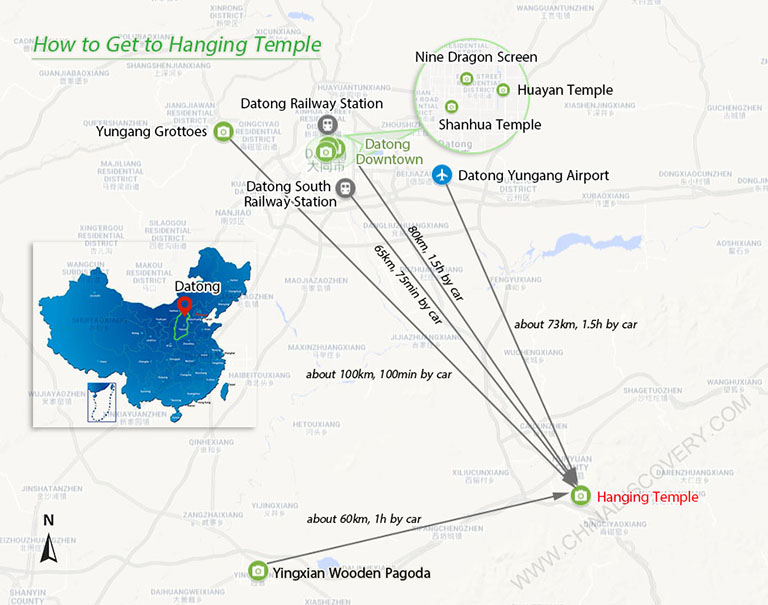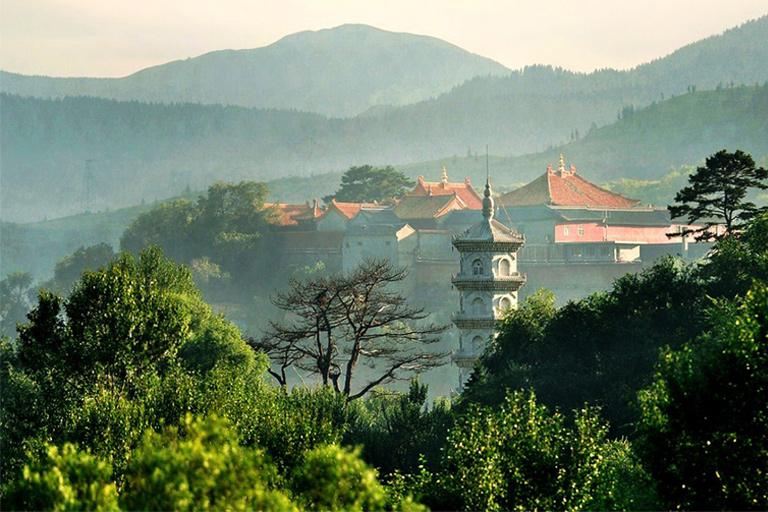Brief Introduction of the Hanging Temple
Located in Hunyuan County, Datong, Shanxi Province, Hanging Temple (also called Hanging Monastery or Xuankong Si) is famous for its precipitous location, and it’s the only existing temple which is dedicated to three religions: Buddhism, Taoism and Confucianism. It is quite rare to see the saints of the three religions being enshrined in one temple. It is said that this is also part of the reason this temple can survive the vicissitude of dynasties in the history.
The Hanging Temple was constructed in the late Northern Wei Dynasty (A.D. 491) and has a long history of over 1500 years. Its most attractive part is that the whole temple is protruding from the cliff of Cuiping Peak and is 50 meter above the ground.
Times magazine selected the Hanging Temple as one of the Top 10 Unique and Precipitous Architectures in 2010.
Why Can the Hanging Temple Cling to the Cliff Firmly
Almost everyone who sees the Hanging Temple will wonder: Why can it stand firmly on the cliff for 1500 years? Some people think it owes to the a dozen of standing pillars. But they are actually added long after the Hanging Temple was built to reassure people who were afraid that it would fall down. What actually support the temple are the 27 cantilevers inserted deeply into the cliff-side. The top of the cantilever beams is jacked with wedges. When they are put into the holes drilled on the wall, the wedges will firmly stick on the stone walls, which are similar to today's expansion bolts. The deeper they are drilled, the more firmly they are fixed.
The design and site selection of Hanging Temple is another important reason for its preservation. It's located at the inward concave of the cliff and the protruding part is like an umbrella, which makes the temple free from the impact of rain and falling rocks. The high position of the temple also avoids the risk of being flooded.
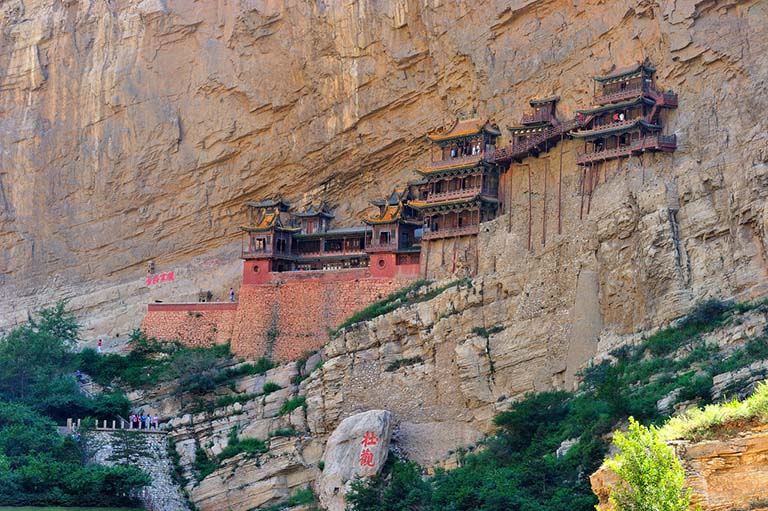
Hanging Temple on the Cliff
What to See in Hanging Temple
Seen from afar, the hanging temple is just like an exquisite relief inlaid in the cliffs and it seems that there is not much space inside. But when you go inside, you will find that it has all the things that a temple should have. The whole temple is 32m long and can be divided into three parts.
Southern Part: The southere part has three floors in total, and it’s about 8m long and 4m wide. It has Chunyang Palace, Sanguan Hall and Leiyin Hall. Chunyang Palace is mainly worshiping Lü Dongbin - one of the Eight Immortals of Taoism. Sanguan Hall is the largest hall of Hanging Temple. Sanguan means three officials, which refer to the heavenly official who blesses people, the earth official who forgives sins, and the water official who relieves the people of their troubles. The clay sculptures in the hall are the precious works from the Ming Dynasty (A.D. 1368 - 1644), among which the largest one is 2 meters in height. Leiyin Hall is a Buddhism hall and it’s located at the highest part of the southern part. “Leiyin” literally means the “sound of thunder”. Buddhist believes that when Buddha Sakyamuni carries forward Buddhism, his voice is as loud as thunder, so it is called Leiyin Hall.
Northern Part: The northern part is about 7m long and 4m wide. It has Wufo Hall, Guanyin Hall and Sanjiao Hall. Wufo Hall is the lowest hall of the three, and is famous for worshiping the Five Dhyani Buddhas. Guanyin Hall lies in the middle part, while Sanjiao Hall is located at the top. Sanjiao (mean “three religions” in Chinese) Hall is the symbol of the combination of three religions, and the statue of the founders of the three religions - Shakyamuni of Buddhism, Laozi of Taoism and Confucius of Confucianism are worshiped in this hall.
Changxian Bridge: Changxian Bridge is a 10m hanging plank road that connects the southern part and northern part.
√ 4 Days Essence of Datong & Pingyao Tour with Hanging Temple
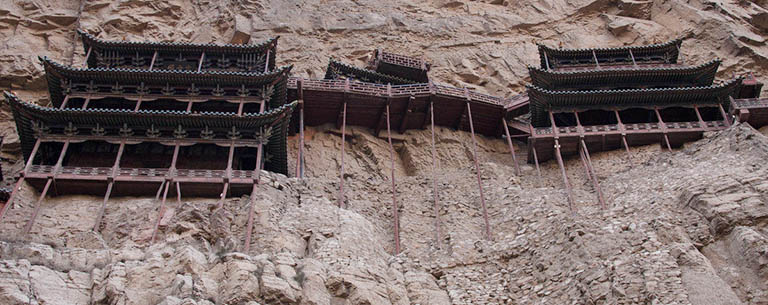
Hanging Temple
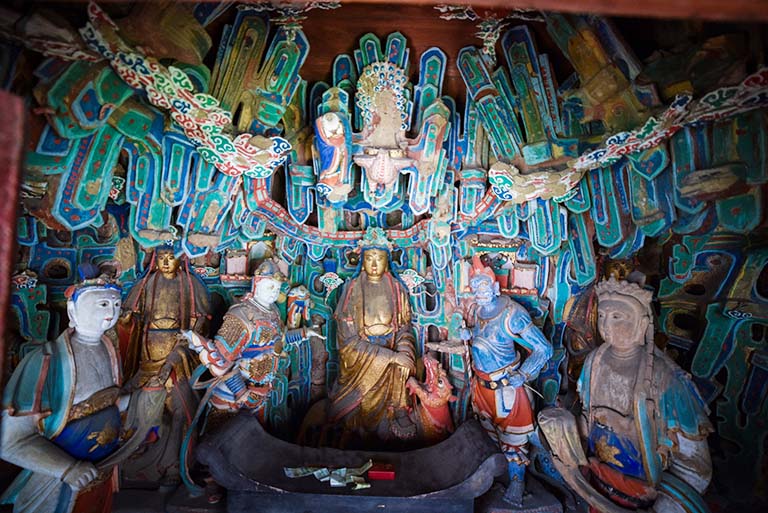
Colored Sculpture in Hanging Temple
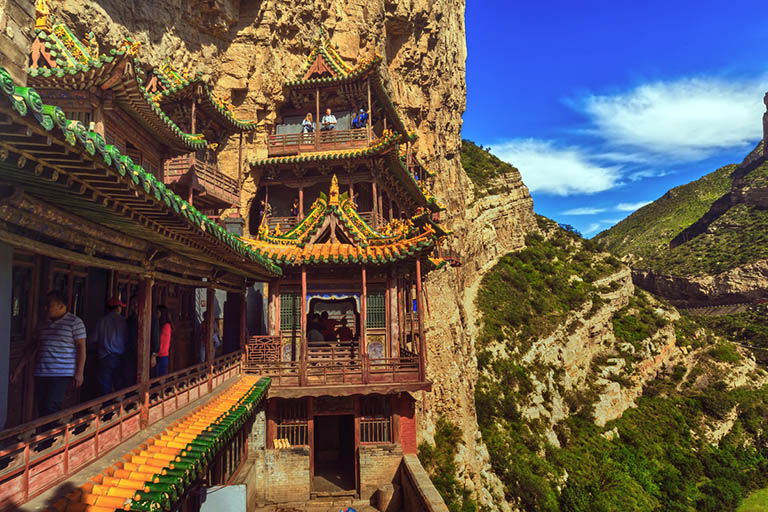
Corridor Connected Pavilions on Hanging Temple
Hanging Temple Location & Transportation
The Hanging Temple is located at the foot of Mt. Hengshan, in the southeast of Hunyuan County, Datong.
- 80km away from Datong city center, about 1.5 hours' drive;
- 65km away from Datong South Railway Station, about 75 minutes' drive;
- 73km away from Datong Airport, about 1.5 hours' drive.
Getting to Datong First: Before getting to Hanging Temple, you are suggested to reach Datong city first. It is recommended to take a high speed train from Beijing (2~2.5 hrs), Xian (6 hrs), Pingyao (3~3.5hrs), Taiyuan (2~2.5 hrs), etc. Flight is also available to take you to Datong from Beijing (1h), Shanghai (2.5h), Chongqing (2.5h), Xian (2h), Chengdu (2.5h) and Wuhan (2h), etc.
Datong to Hanging Temple Transfer: It is recommended to drive or charter a car from the main transportation hub (like Datong South Railway Station, Datong Railway Station, Datong Yungang Airport, etc.) to the Hanging Temple because taking a bus will need several transfers. You can also book a private Datong trip package from us that covers the transfer, ticket, accommodation, meal, etc. to save all the troubles. Read more about How to Get to Hanging Temple>
Best Time to Visit Hanging Temple
As a historical site, the Hanging Temple is available to visit all year round. But considering Datong in winter is relatively cold and there will be more tourists in July and August, it is most recommended to travel here from March to mid-June and mid-September to November.
Best time to visit in a day: To protect the temple, the number of visitors is limited at 80, which means when there are 80 people in the temple, you need to wait until someone comes down from the temple and then you are allowed to go up there. Therefore, it is recommended to visit the Hanging Temple in the morning and be one of the first batch of 80 people, or it is normal to wait in line for 1-2 hours.

Hanging Temple in Autumn
Where to Stay in Your Hanging Temple Trip
Most hotels around the Hanging Temple are in Hunyuan County. It is a small county in Datong suburb, so the accommodation condition may not be as good as that in Datong. But if you plan to stay here, there are also some comfortable hotels you can choose such as Hengshan International Hotel and Hengjili Hotel. But for better accommodation, we suggest you travel back to Datong city to stay a night. The downtown area of Datong offers a great number of hotels with different classes from luxurious ones to budget ones. You can also enjoy convenient access to shopping malls, restaurants, business streets, etc. It is also easy to travel to other attractions in Datong city, like Datong Museum, Nine Dragon Screen, Huayan Temple, and Shanhua Temple. Read more about Where to Stay in Datong >
How to Plan a Datong Tour
Best time to visit Datong: March to mid-June, mid-September to November
How to get to Datong: High speed train from Beijing (2-2.5h), Taiyuan (2-2.5h), Pingyao (3-3.5h) and flights from Xian (2h), Chengdu (2.5h), Shanghai (2.5h), etc.
Where to stay in Datong: It is most recommended to stay in Datong downtown near Huayan Temple where there are many choices from 5-star luxury hotels to 3-star economy ones. What's more, it is convenient to get to main attractions in Datong such as Yungang Grottoes and Hanging Temple from this area.
It usually needs 2 days to cover the highlights in Datong. Without any doubt, Yungang Grottoes is a must. It consists of 53 grottoes with 51,000 statues and is a real treasure of traditional Chinese art. After that, you can go to Shanhua Monastery to appreciate a set of well-preserved buildings of Liao Dynasty (905-1125). Then, continue to have a look at Nine Dragon Screen, the oldest and largest glazed screen in China and later head to Huayan Temple, which keeps the largest wooden structure of Buddhist temple hall with elegant mural and scriptures. The next day is for the attractions a little far from downtown such as Hanging Temple, an unusual temple standing on the precarious cliff built over 1500 years ago, and Yingxian Wooden Pagoda, the highest wooden pagoda in the world.
☛ 2 Days Datong Yungang Grottoes Tour
☛ 3 Days Datong Culture Tour with Hanging Temple
In addition, the convenient transportation of Datong provides opportunities to discover more of Shanxi to Taiyuan, sacred Buddhist mountain Mount Wutai, world heritage site Pingyao Ancient City, magnificent Hukou Waterfall, etc.
☛ 4 Days Essence of Datong & Pingyao Tour
☛ 5 Days Datong & Wutaishan Discovery Tour
☛ 6 Day Datong Pingyao Tour Plus Wutaishan Visit
If you have more days and want to travel outside Shanxi, it is highly recommended to extend your tour to capital Beijing (Great Wall, Forbidden City), time-honored Xi’an (Terracotta Warriors), and modern metropolis Shanghai (the Bund).
☛ 9 Days Ancient Treasures of China Tour
☛ 11 Days Golden Triangle Tour with Shanxi Highlights
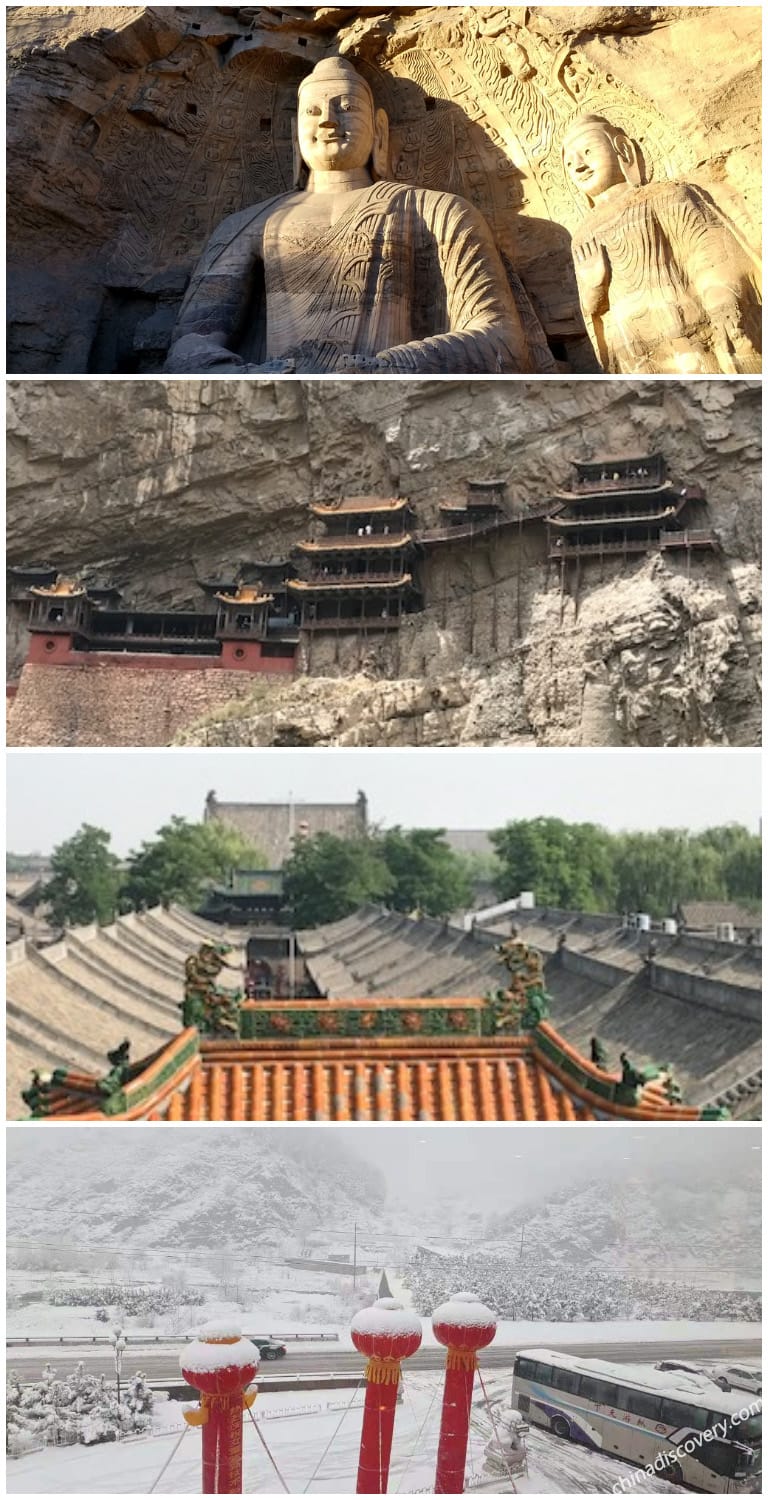
Yungang Grottoes, Hanging Temple, Pingyao and Mount Wutai in Shanxi
- Datong City Tours
- Datong Pingyao Tours
- Beijing Datong Tours
Top Datong Tours
Helpful Datong Travel Guide
- How to Plan Datong Trip
- Yungang Grottoes
- Yingxian Wooden Pagoda
- Top Attractions in Datong
- Things to Do in Datong
- Get There & Around
- Get to Hanging Temple
- Get to Yungang Grottoes
- Where to Stay
- Weather & Seasons
- Datong Maps
- More Travel Guide
More about Shanxi Travel Guide
- How to Plan a Shanxi Tour
- Shanxi Tours
- Places to Visit in Shanxi
- Shanxi Attractions
- Shanxi Activities
- Shanxi Transportation
- Hotels in Shanxi
- Shanxi Weather & Seasons
- Shanxi Maps
- More Shanxi Travel Guide
- Pingyao Travel Guide
- Mount Wutai Travel Guide
- Taiyuan Travel Guide
- Hukou Waterfall Travel Guide
- Linfen Travel Guide
- Yuncheng Travel Guide
- Jincheng Travel Guide
- Changzhi Travel Guide
Recommended Datong Tours
Top 3 Datong tours chosen by most customers to explore Datong in the best way. Check the detailed itinerary, or tailor your own trip now with us.

6 Day Datong Pingyao Tour Plus Wutaishan Visit
Datong / Wutaishan / Taiyuan / Pingyao
Start planning your tailor-made holiday to China by contacting one of our specialists. Once inquired, you’ll get a response within 0.5~23.5 hours.
Customize a TripHave a question? Get answers from our travel experts or guests
- Your Question:
- Your Name:
- Your Email:
- Submit


























